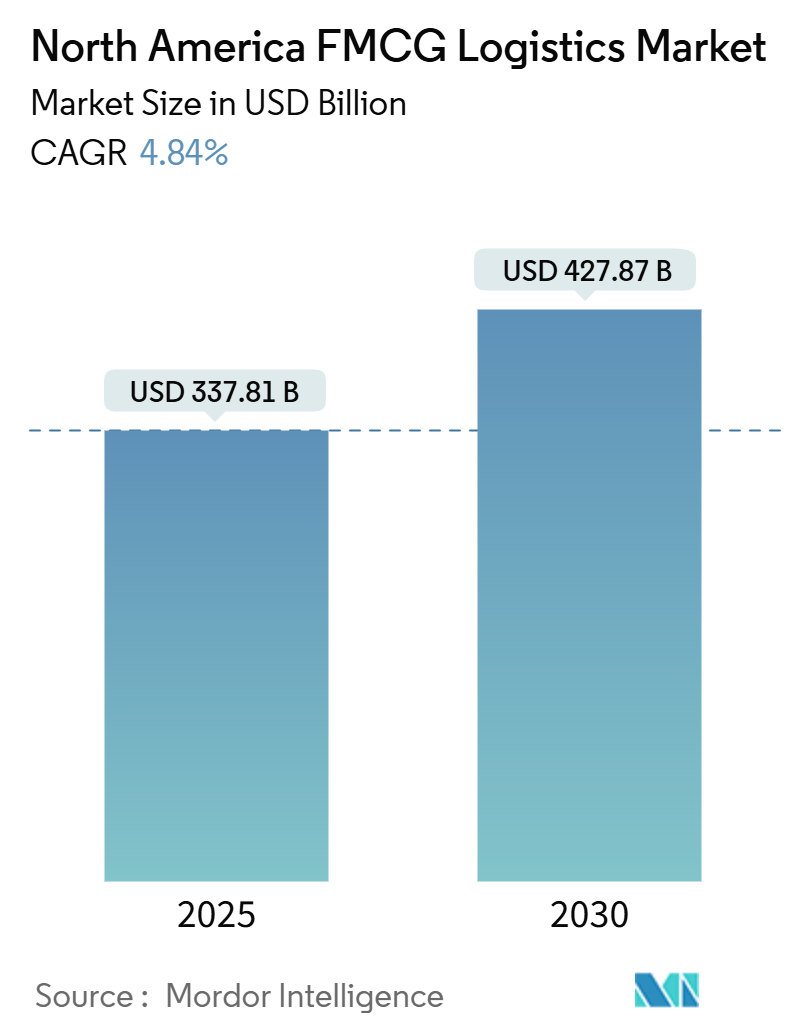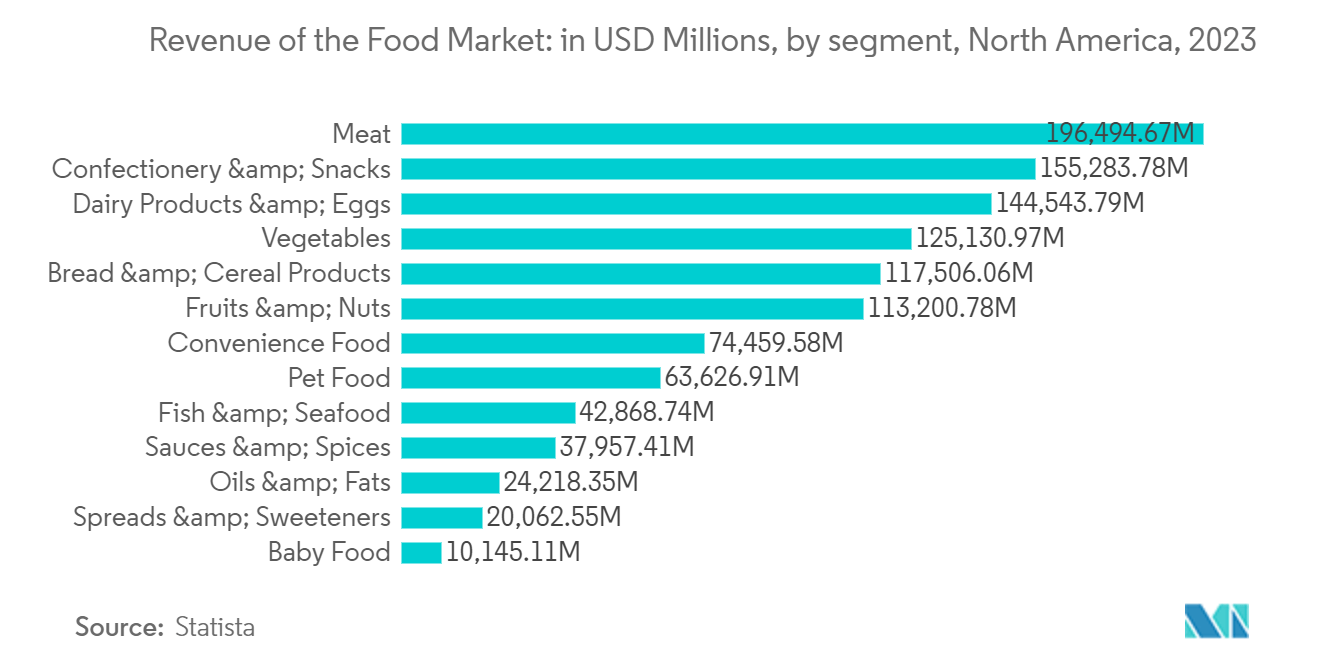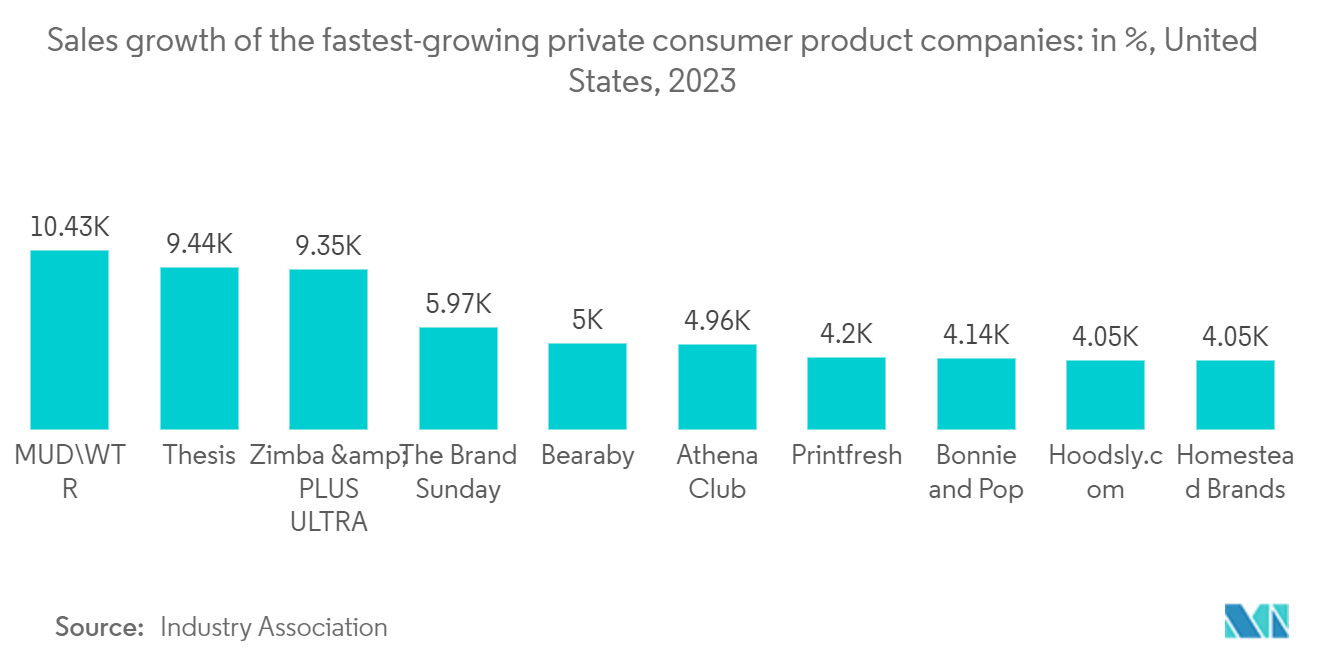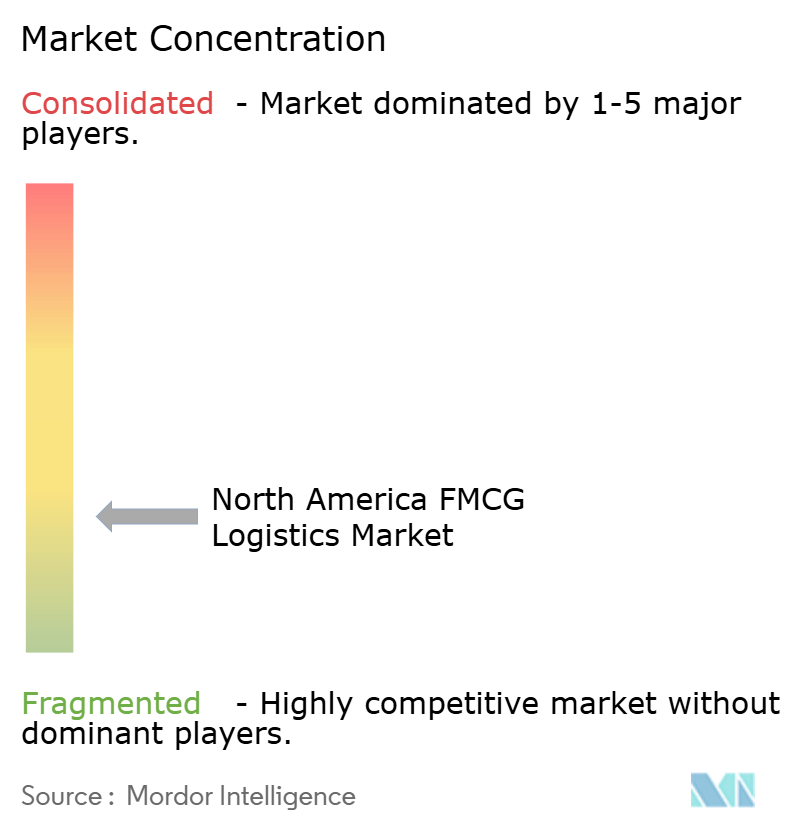North America FMCG Logistics Market Analysis
The North America FMCG Logistics Market size is estimated at USD 337.81 billion in 2025, and is expected to reach USD 427.87 billion by 2030, at a CAGR of 4.84% during the forecast period (2025-2030).
E-commerce sales in North America have grown by nearly 60% since the beginning of the pandemic, driving increased demand for FMCG logistics services. There has been a notable shift to food-at-home consumption, with the food-at-home market surging 8.7%, which is four times its historical growth rate.
This has increased pressure on FMCG logistics to handle higher volumes of grocery and food deliveries. Consumers now expect fast order fulfillment through multiple channels. This has led FMCG companies to outsource their logistics operations to bridge the gap between sales planning and operational processes, improve forecasting, streamline inventory, and speed up delivery times.
The move to eating food at home coincides with a growing emphasis on healthier eating. The FMCG sector has benefited from the current e-commerce growth. The industry is moving into a new era of supply chain management from traditional storekeeping, purchasing, materials management, and integrated materials management.
FMCG companies often conduct their logistics operations using a hub-and-spoke model, with distribution hubs in important cities and towns serving both wholesalers and retailers. Customers anticipate quick order fulfillment via a variety of channels. Consumer goods firms outsource their logistics operations to do this by bridging the gap between operational and sales planning processes, enhancing forecasting, streamlining inventory, and accelerating delivery times.
The market growth has been driven partly by demand for healthier foods high in proteins, vitamins, minerals, and fats that must be transported within specific temperature windows. With labor shortages anticipated to continue throughout the supply chain, many cold chain companies are looking toward automated solutions. The pre-COVID Canadian cold storage landscape was growing, with trends in domestic and global food markets driving much of that demand.
North America FMCG Logistics Market Trends
Increasing Growth in Food and Beverages Products are Driving the Market Growth
North American consumers are increasingly demanding fresh and healthy foods, which require specialized logistics capabilities to ensure that they are delivered to consumers in a timely and quality manner. This is driving demand for cold chain logistics, as many fresh and healthy foods must be kept at a specific temperature throughout the transportation and storage process. The e-commerce market for food and beverages is growing rapidly in North America. Experts predicts e-commerce will increase a modest 2.4 percentage points in United Staes over the next five years upto 2027, underscoring the challenges retailers face in balancing sales with profitability. The firms noted that health concerns from COVID-19 and other illnesses will likely continue to encourage online grocery shopping.
The US retail landscape is a blend of traditional brick-and-mortar, digital, and hybrid stores, where large chains coexist with smaller businesses, offering consumers a diverse shopping experience. In the US, the food and beverage market is heavily influenced by consumer-driven trends, primarily focusing on health, sustainability, and technology.
With a growing emphasis on healthy living and affordability, the frozen food category in the US has seen significant growth. However, challenges persist, such as the risk of goods spoiling during transportation or warehouse delays, especially in facilities spanning over 2 million square feet and managing thousands of shipments. To address these challenges, technologies like digital twins are emerging as crucial tools, helping to prevent congestion, delays, and subsequent risks like food spoilage and energy wastage.
In Canada, the food and beverage processing industry stands out as the largest manufacturing sector by value production. In 2022, it recorded sales of USD 156.5 billion, representing 18.2% of total manufacturing sales and 1.7% of the national GDP. Notably, exports of processed food and beverage products hit a record high of USD 54.3 billion, marking a 14.1% increase from 2021 and constituting 7% of Canada's total exports.
The sector experienced a robust 10.6% growth in 2022, with meat product manufacturing leading in sales, closely followed by grain and oilseed milling, and dairy product manufacturing. Looking ahead to 2025, the beverage category is poised to outshine the broader food and beverage market, driven by the introduction of new products, notably protein, energy, and low-alcohol options.
Consumers' increasing preference for turnkey solutions, especially on-the-go, and the demand for innovative frozen products, underscores the industry's need to cater to evolving consumer tastes, emphasizing convenience, quality, and value.
In conclusion, both the US and Canadian food and beverage markets are evolving rapidly, driven by consumer preferences and technological advancements. The US market is seeing a surge in demand for health-conscious and sustainable products, while Canada is experiencing significant growth in its food and beverage processing industry. As these trends continue, businesses must innovate and adapt to meet the changing needs of consumers, ensuring they remain competitive in a dynamic market landscape.
United States Leading the market in North America
Industry sources project that FMCG e-commerce sales in the United States will soar to USD 1.6 trillion by 2025. This surge is fueling the need for more effective and dependable FMCG logistics solutions. With a rising appetite for fresh and perishable goods, consumers are demanding specialized logistics to guarantee timely and safe deliveries.
Notably, US consumers' disposable income has seen a consistent uptrend, providing them with more purchasing power for FMCG items. As an illustration, organic food sales in the US are poised to hit USD 100 billion by 2025.
The US demographic landscape is evolving, marked by increasing diversity and an aging population. This shift is opening up fresh avenues for FMCG companies to tailor products to these changing demographics. As of July 2022, the US Census Bureau pegged the nation's population at 333,287,557. Notably, the surging Hispanic community in the US is spurring a heightened appetite for Hispanic-inspired food and beverages. For instance, salsa sales in the US have surged by 50% over the past decade.
E-commerce is witnessing a meteoric rise in the US, simplifying FMCG purchases for consumers and propelling the emergence of new categories like online grocery delivery. Moreover, there's a pronounced demand for personal care products, particularly among millennials and Gen Z. This heightened demand is reshaping the FMCG logistics landscape, necessitating providers to efficiently transport and deliver these goods.
Highlighting this trend, UPS has forged a partnership with Unilever, unveiling a dedicated logistics service for personal care products. This service leverages temperature-controlled vehicles and warehouses to ensure Unilever's offerings reach customers in optimal condition.
In conclusion, the FMCG market in the United States is undergoing significant transformation driven by e-commerce growth, demographic shifts, and rising disposable incomes. These factors are not only expanding the market but also necessitating advancements in logistics solutions to meet evolving consumer demands. Companies that can adapt to these changes and invest in specialized logistics will be well-positioned to capitalize on the burgeoning opportunities in the FMCG sector.
North America FMCG Logistics Industry Overview
The report focuses on the key players in the North American FMCG Logistics Market. The market is highly competitive, with many local and international players. The opportunity for FMCG logistics service providers has increased due to COVID's impact and is expected to continue in the coming years. Some of the major players in the FMCG logistics market include DHL Group, C.H. Robinson Worldwide Inc., Kuehne + Nagel, Agility Logistics, CEVA Logistics, and FedEx, among others.
North America FMCG Logistics Market Leaders
-
DHL
-
C. H. Robinson
-
Kuehne + Nagel
-
CEVA Logistics
-
FedEx
- *Disclaimer: Major Players sorted in no particular order
North America FMCG Logistics Market News
- April 2024: NewCold, the fast-growing leader in advanced automated warehouse and cold chain logistics, announced plans to invest USD 222 million and create over 50 new jobs in Alberta’s agri-food sector. With support from Invest Alberta and a grant from the Government of Alberta, NewCold will expand into the southern Alberta community of Coaldale, creating a cutting-edge food storage facility that will build on the region’s strength as Canada’s premier food corridor and contribute to long-term regional economic growth.
- July 2023: Darwynn, a leading Ontario-based end-to-end fulfillment ecosystem, and JD Logistics, a prominent technology-driven supply chain solutions and logistics service provider, have announced a strategic partnership to empower sellers with seamless access to the North American market. This collaboration leverages the strengths of both companies, with Darwynn operating four facilities in Canada and JD Logistics operating six facilities in the United States, enabling sellers to benefit from comprehensive B2B and B2C offerings across North America.
North America FMCG Logistics Industry Segmentation
FMCG logistics management is concerned with the efficiency and effectiveness with which daily activities involving the transportation of daily usable goods from one location to another are managed. It is the management of the flow of goods from one point of origin to another to meet the needs of customers. A comprehensive analysis of the North American FMCG Logistics Market includes an examination of the economy and market overview, estimation of market size for key segments, and emerging trends in market segments. The report sheds light on market trends like growth factors, restraints, and opportunities in this sector. The competitive landscape of the North American FMCG logistics market is depicted through the profiles of active key players. The report also covers the impact of COVID-19 on the market and future projections.
The North American FMCG Logistics Market is segmented by service (transportation, warehousing, distribution, inventory management, and other value-added services), product category (food and beverage, personal care, household care, and other consumables),, and geography (United States, Canada, and Mexico). The report offers market size and forecasts in dollars (USD) for all the above segments.
| By Service | Transportation |
| Warehousing, Distribution, and Inventory Management | |
| Other Value-added Services | |
| By Product Category | Food and Beverage |
| Personal Care | |
| Household Care | |
| Other Consumables | |
| By Geography | United States |
| Canada | |
| Mexico |
| Transportation |
| Warehousing, Distribution, and Inventory Management |
| Other Value-added Services |
| Food and Beverage |
| Personal Care |
| Household Care |
| Other Consumables |
| United States |
| Canada |
| Mexico |
North America FMCG Logistics Market Research FAQs
How big is the North America FMCG Logistics Market?
The North America FMCG Logistics Market size is expected to reach USD 337.81 billion in 2025 and grow at a CAGR of 4.84% to reach USD 427.87 billion by 2030.
What is the current North America FMCG Logistics Market size?
In 2025, the North America FMCG Logistics Market size is expected to reach USD 337.81 billion.
Who are the key players in North America FMCG Logistics Market?
DHL, C. H. Robinson, Kuehne + Nagel, CEVA Logistics and FedEx are the major companies operating in the North America FMCG Logistics Market.
What years does this North America FMCG Logistics Market cover, and what was the market size in 2024?
In 2024, the North America FMCG Logistics Market size was estimated at USD 321.46 billion. The report covers the North America FMCG Logistics Market historical market size for years: 2019, 2020, 2021, 2022, 2023 and 2024. The report also forecasts the North America FMCG Logistics Market size for years: 2025, 2026, 2027, 2028, 2029 and 2030.
Page last updated on: January 15, 2025
North America FMCG Logistics Industry Report
Statistics for the 2025 North America FMCG Logistics market share, size and revenue growth rate, created by Mordor Intelligence™ Industry Reports. North America FMCG Logistics analysis includes a market forecast outlook for 2025 to 2030 and historical overview. Get a sample of this industry analysis as a free report PDF download.







